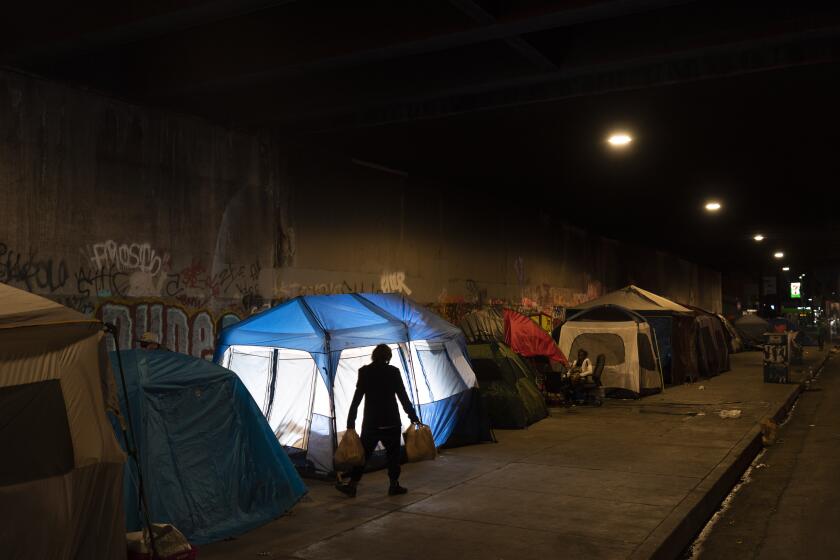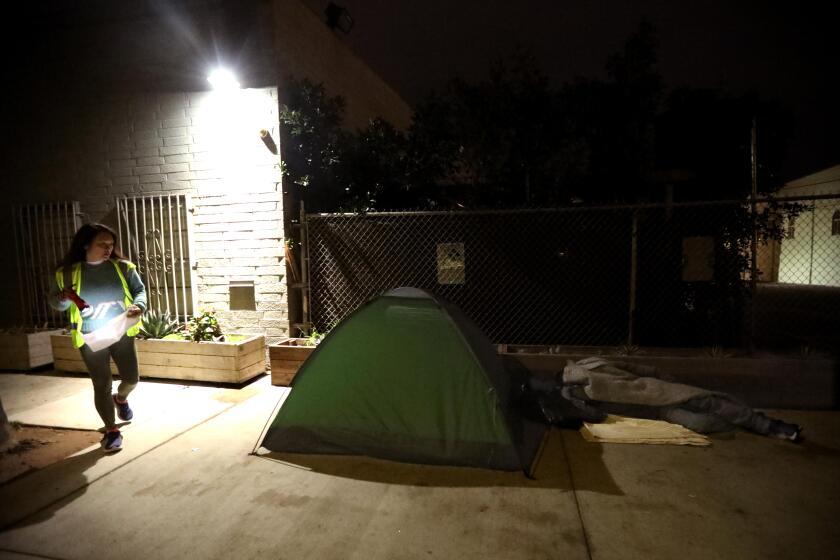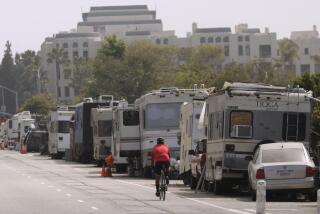Editorial: Towing RVs without offering help only leaves more people living on the street

- Share via
There are more than 6,800 RVs in Los Angeles County that unhoused people call home, according to the 2024 homeless count. That’s more than the number of tents (about 4,200) recorded in that same survey. Of those, 3,691 are in the city of Los Angeles.
Recreational vehicles have appeared across the county and the city of Los Angeles, sometimes parked alone on a street, sometimes in groups that spread over several blocks. Some are dilapidated and inoperable. Others are in working condition and people can drive them from location to location.
But unlike a tent or cardboard lean-to, RVs offer substantial security, privacy and shelter. And in many other places, people are allowed to live full time in RVs. So understandably, RV dwellers often don’t think of themselves as homeless and few want to trade their vehicle for a bed in a group shelter. (Who would?)
Black people represent only 8% of the city’s population but make up 34% of the unhoused. Centuries of American racism create the effects we see today.
Over the years, as neighborhoods have complained about trash, fires and crime at some RV encampments, Los Angeles city officials have struggled to figure out how to convince this segment of the unhoused population to leave their vehicles behind.
Unfortunately, the L.A. City Council’s recent solution — to tow illegally parked RVs in some areas without doing outreach or offering services or temporary housing — is likely to backfire and runs counter to the city’s efforts to reduce street homelessness.
If you kick homeless people out of their RVs, they may end up living in a tent on the sidewalk next to where they were parked. The RV may be gone, but its occupants are even more unsheltered than they were. That’s ridiculous. This may be a challenging situation, but this is just the wrong way to deal with it.
In fact, the council’s motion is so broad that it directs transportation officers to tow away “any and all vehicles” that are stopped or parked in violation of numerous parking restrictions. The Legal Aid Foundation of Los Angeles, in a letter to the city attorney, said the council overstepped its authority in ordering towing of vehicles that may violate parking restrictions but don’t constitute a traffic or public safety hazard or aren’t parked in posted tow-away zones.
New homeless numbers show a slight decrease in L.A.’s homeless population. The takeaway: Inside Safe and other efforts to house people are working.
We understand that RV encampments can pose problems. They are big and bulky, and make it difficult for other drivers to navigate around. They permanently take up parking spaces, sometimes along city parks. RV dwellers have been known to dump their septic tanks into the streets. Some RV occupants end up moving belongings into the adjacent street or sidewalk.
Over the years, the city has tried to discourage encampments by putting up signs on streets prohibiting overnight parking of oversized vehicles. When that happens, RV dwellers simply move to another street or, in some cases, remain there. The city can only tow so many because there isn’t enough city-controlled storage even for the short term. Still, between May 2022 and June 2024, the city issued 1,134 parking citations to RVs and towed 638 of them. (Towing stopped during the pandemic and resumed in 2022.) It is also expensive. Towing, storing and ultimately dismantling and recycling RVs could cost the city millions of dollars.
One thing is certain — the city can’t just tow its way out of the problem. A more prudent strategy would be to follow the process for moving people out of tent encampments. This approach has already shown it can work. City officials have increased outreach to RV campers in recent years, including through Mayor Karen Bass’ Inside Safe program, which offers people in encampments interim housing, mostly in motels and hotels. RV campers will often accept motel or hotel rooms, though some won’t when the offer is contingent on relinquishing the RV. Since June 2022, 196 RV dwellers took housing.
City Councilmember Monica Rodriguez and the nonprofit West Valley Homes YES collaborated on a pilot program that began in 2022 in the San Fernando Valley and has successfully housed 146 RV dwellers. Councilmember Nithya Raman, the current chair of the City Council’s Housing and Homelessness Committee, has pushed for a citywide strategy to house RV dwellers and offer them cash or gift cards to part with their vehicles. It worked in Rodriguez’s district. People are understandably reluctant to give up their vehicles. A $500 incentive may help. But service providers say campers worry about what they will do if the motel stay doesn’t work out and their RV is long gone.
The city should consider other options as well, including using city lots to offer short-term RV storage and opening safe parking lots for RVs. The lots would need to be physically bigger than those for cars, and open 24 hours — unlike the city’s current safe parking lots that are open only at night. But it would probably be less complicated and less expensive than offering up thousands of motel rooms for several months. Instead of spending all its efforts trying to get people out of RVs, the city should work on finding or creating places that are safe for RVs.
This process takes time. Nonetheless, city officials should continue to ramp up efforts to reach out to RV dwellers and offer them housing. Towing illegally parked RVs without doing that may get rid of RVs but will leave more people living on the street.
More to Read
A cure for the common opinion
Get thought-provoking perspectives with our weekly newsletter.
You may occasionally receive promotional content from the Los Angeles Times.












